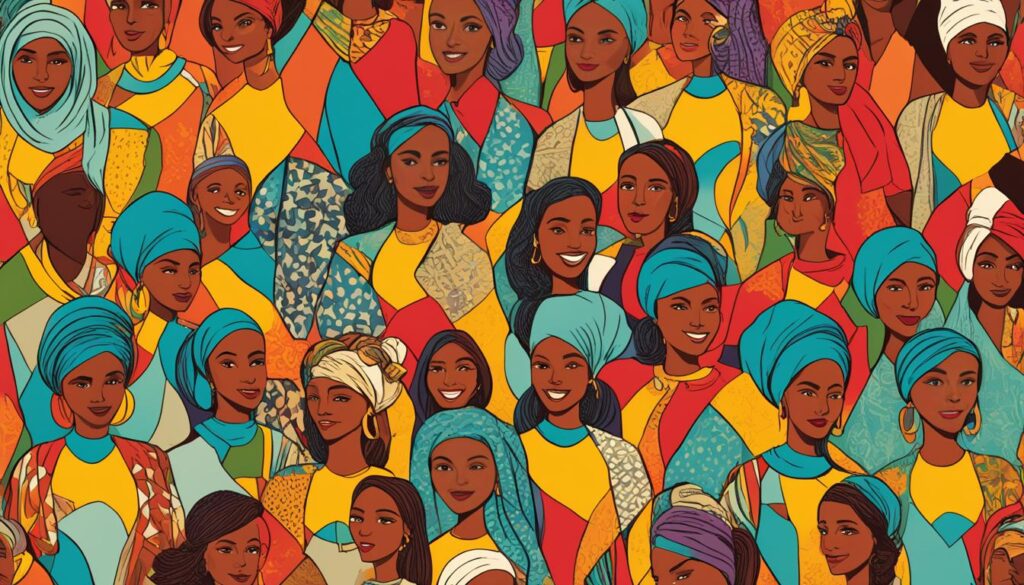Did you know that women’s empowerment remains a challenge in Africa? Despite progress in various areas, gender gaps and disparities persist, hindering the overall empowerment of women in the region.
In terms of education, women and girls in Eastern and Southern Africa face significant disparities and barriers. Maternal health challenges, including discrepancies in mortality rates and deficiencies in healthcare facilities, further impede progress. Gender-based violence and discrimination in asset ownership also pose significant obstacles.
However, there is hope. Efforts and strategies are being implemented to improve these statistics and empower African women. This article explores the most recent data on women empowerment in Africa, highlighting the challenges and progress made towards promoting gender equality.
Key Takeaways:
- Women empowerment remains a challenge in Africa, with significant gender gaps and disparities.
- Education disparities and barriers affect women and girls in Eastern and Southern Africa.
- Maternal health challenges, including mortality rates and healthcare deficiencies, hinder women’s empowerment.
- Gender-based violence and discrimination in asset ownership pose significant obstacles.
- Efforts and strategies are being implemented to improve women empowerment statistics in Africa.
Educational Disparities and Their Impact
In Eastern and Southern Africa, educational disparities have significant implications for the empowerment of women and girls. One area where these disparities are evident is in secondary school completion rates. Unfortunately, girls in countries across the region have lower completion rates compared to boys.
Secondary School Completion Rates in Eastern and Southern Africa
The secondary school completion rates for girls in Eastern and Southern Africa are a cause for concern. Data shows that girls are more likely to drop out of school before completing their secondary education. This discrepancy in completion rates has long-term consequences for the empowerment of women, as education plays a crucial role in enhancing their economic opportunities and overall well-being.
Barriers Affecting Girls’ Education
Several barriers contribute to the educational disparities faced by girls in the region. These barriers include:
- Child Marriage: Girls who are married at a young age are more likely to discontinue their education, limiting their future prospects and opportunities.
- Poverty: Economic challenges often prevent girls from accessing educational resources and support, as families prioritize other needs.
- Cultural Norms: Deep-rooted cultural norms may perpetuate gender inequalities, restricting girls’ access to education and reinforcing traditional gender roles.
- Lack of Access: Limited access to educational facilities, especially in rural areas, hinders girls’ ability to attend and complete secondary school.
These barriers to girls’ education further deepen the educational disparities in the region and perpetuate gender inequities.
Labor Force Participation and Gender Gaps
Gender gaps in labor force participation persist in Africa. Women are less likely to be employed and face unequal access to productive resources and opportunities compared to men. They often work in lower-paying sectors and face lower productivity and earnings. These gender gaps limit women’s economic empowerment and hinder overall development. Efforts are being made to address these disparities and promote gender equality in the labor market.
Improving labor force participation and reducing gender gaps is crucial for women’s economic empowerment. It requires creating an inclusive and supportive environment that values and promotes equal opportunities for men and women in the workplace. Organizations, governments, and societies have a collective responsibility to eliminate gender bias and discrimination, ensuring that women have access to education, training, and resources necessary to succeed in their chosen fields.
“Closing the gender gap in labor force participation is not only a matter of equality, but also a driver of economic growth. Empowering women economically has positive ripple effects on families, communities, and nations as a whole.” – United Nations Women
Addressing gender gaps in labor force participation requires comprehensive strategies and interventions. These may include:
- Implementing policies that promote equal pay and equal opportunities in the workplace.
- Providing access to affordable and high-quality childcare to support working mothers.
- Offering vocational training and skills development programs targeted at women.
- Promoting entrepreneurship and supporting women-owned businesses.
- Advocating for flexible work arrangements and work-life balance policies.
By addressing gender gaps in labor force participation, societies can unlock the full potential of women, contribute to economic growth, and advance women’s economic empowerment.
Maternal Health Challenges in Africa
Maternal health is a significant challenge in Africa, with discrepancies in maternal mortality rates across countries. Limited access to quality primary healthcare facilities contributes to these disparities. Additionally, the impact of diseases like HIV/AIDS on maternal health remains a concern. These challenges pose serious risks to women’s well-being and hinder progress in gender equality and women’s empowerment.
Discrepancies in Maternal Mortality Rates
Maternal mortality rates vary significantly across countries in Africa. While progress has been made in reducing maternal deaths, there is still a long way to go. Factors such as inadequate access to quality healthcare, lack of skilled birth attendants, and delays in receiving emergency obstetric care contribute to these discrepancies. Addressing these disparities is essential to ensure the well-being of women during pregnancy and childbirth.
Deficiencies in Primary Healthcare Facilities
The availability and quality of primary healthcare facilities play a crucial role in maternal health outcomes. Many regions in Africa lack well-equipped healthcare centers and trained medical professionals, making it challenging for pregnant women to receive essential antenatal care and safe deliveries. Investments in strengthening primary healthcare systems and improving infrastructure are essential to address these deficiencies.
HIV/AIDS and Its Impact on Maternal Health
HIV/AIDS has a significant impact on maternal health in Africa. Women living with HIV/AIDS face additional challenges during pregnancy and childbirth. They are at a higher risk of complications, such as preterm birth, low birth weight, and mother-to-child transmission of the virus. Access to antiretroviral therapy, prevention of mother-to-child transmission programs, and comprehensive support services are crucial in addressing the dual challenge of maternal health and HIV/AIDS.
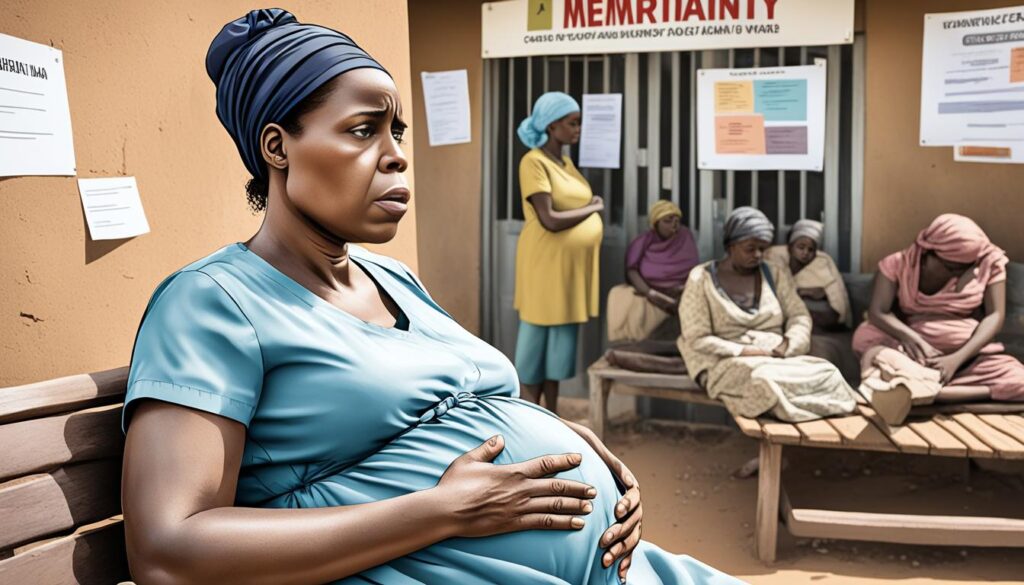
Gender-Based Violence and Ownership of Assets
The prevalence of gender-based violence in Africa is a grave concern, with women being disproportionately affected. Various forms of violence, including physical and sexual violence, pose significant threats to the safety and well-being of women across the continent.
Additionally, women in Africa face discrimination in terms of asset ownership and financial inclusion, which limits their economic empowerment. Unequal access to assets and financial resources hinders their ability to thrive and participate fully in economic activities.
Addressing gender-based violence and promoting equal ownership of assets are critical steps towards achieving women’s empowerment in Africa. Creating safer environments, implementing stricter policies, and providing support services for survivors of violence are essential to combatting gender-based violence. Furthermore, promoting financial inclusion and addressing discriminatory practices in asset ownership can enhance women’s economic empowerment and contribute to overall gender equality.
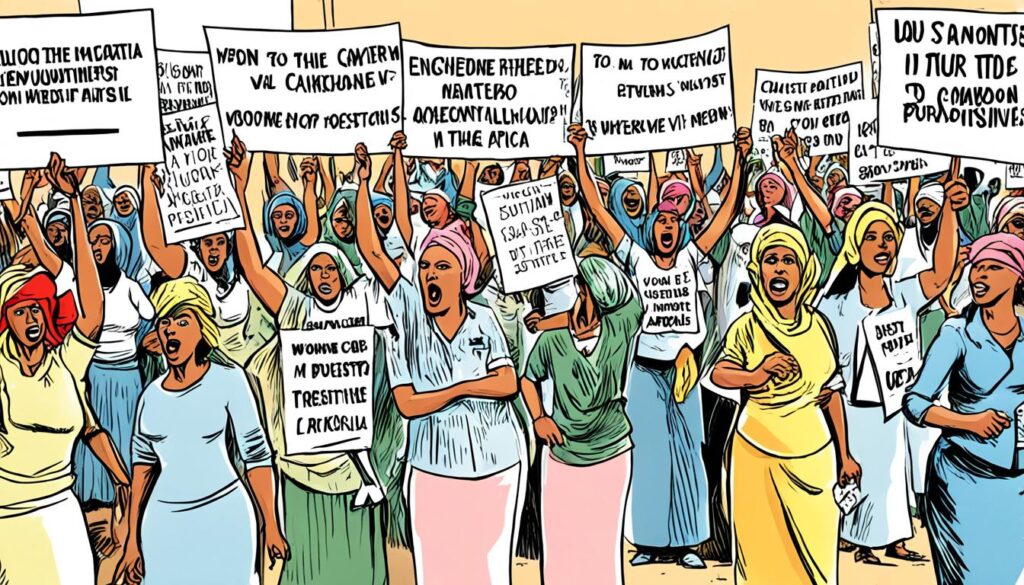
| Forms of Gender-Based Violence | Prevalence |
|---|---|
| Physical violence | Widespread across Africa |
| Sexual violence | Common, affecting women disproportionately |
| Emotional and psychological abuse | Significant, with long-lasting effects on victims |
| Economic abuse | Persistent, limiting women’s financial independence |
Table: Forms of gender-based violence and their prevalence in Africa
Women Empowerment Strategies and Programmatic Efforts
Various strategies and programmatic efforts are being implemented to promote women’s empowerment in Africa. These initiatives aim to address the challenges women face in education, labor force participation, maternal health, gender-based violence, and ownership of assets. Gender equality initiatives, policy reforms, and targeted interventions are key components of these efforts. By implementing comprehensive strategies, organizations and governments seek to achieve progress in women empowerment and gender equality.

“Our goal is to create a future where women have equal opportunities and can fully participate in all aspects of society. To achieve this, we are implementing a range of strategies and programmatic efforts that target the root causes of gender inequality. These initiatives include:
- Providing access to quality education for girls, creating scholarships, and investing in teacher training.
- Promoting women’s economic empowerment through training and mentorship programs, as well as initiatives that support entrepreneurship and access to credit.
- Improving maternal health services by strengthening healthcare systems, providing essential resources, and addressing cultural barriers.
- Fighting against gender-based violence through awareness campaigns, legal reforms, and support services for survivors.
- Promoting women’s ownership and control of assets, including land and property, through legal reforms and advocacy.
These strategies and programmatic efforts are designed to create systemic change and empower women at all levels of society. We believe that by addressing the multiple barriers that women face, we can drive lasting impact and achieve gender equality for all.”
By implementing these women empowerment strategies and programmatic efforts, we can create a more equitable society that values and uplifts women. Together, we can overcome the challenges that hinder women’s empowerment and work towards a future of gender equality in Africa.
Women Empowerment Statistics across Africa
Statistics show that progress is being made in women’s empowerment across Africa. Efforts focused on improving health and nutrition, boosting economic opportunities, and advancements in ownership and control of assets have contributed to positive outcomes for women in the region.
Improving Health and Nutrition Through Strategic Interventions
Strategic interventions aimed at improving the health and nutrition of African women have yielded significant results. Access to quality healthcare services, reproductive health education, and nutrition programs have positively impacted the well-being of women. These interventions have helped to address health disparities and improve overall health outcomes for women, ultimately contributing to their empowerment.
Boosting Economic Opportunities for African Women
Economic empowerment plays a crucial role in women’s empowerment. Efforts to boost economic opportunities for African women have led to increased participation in entrepreneurship, formal employment, and economic decision-making processes. Initiatives such as financial literacy programs, vocational training, and access to microfinance services have created pathways for women to become economically self-sufficient and achieve financial independence.
Advancements in Ownership and Control of Assets
Advancements in ownership and control of assets, such as land and property, have been instrumental in promoting women’s empowerment across Africa. Efforts to address gender disparities in asset ownership and inheritance rights have given women greater control over economic resources, providing them with a sense of security and agency. This progress has helped to challenge traditional gender norms and promote gender equality in terms of property ownership.
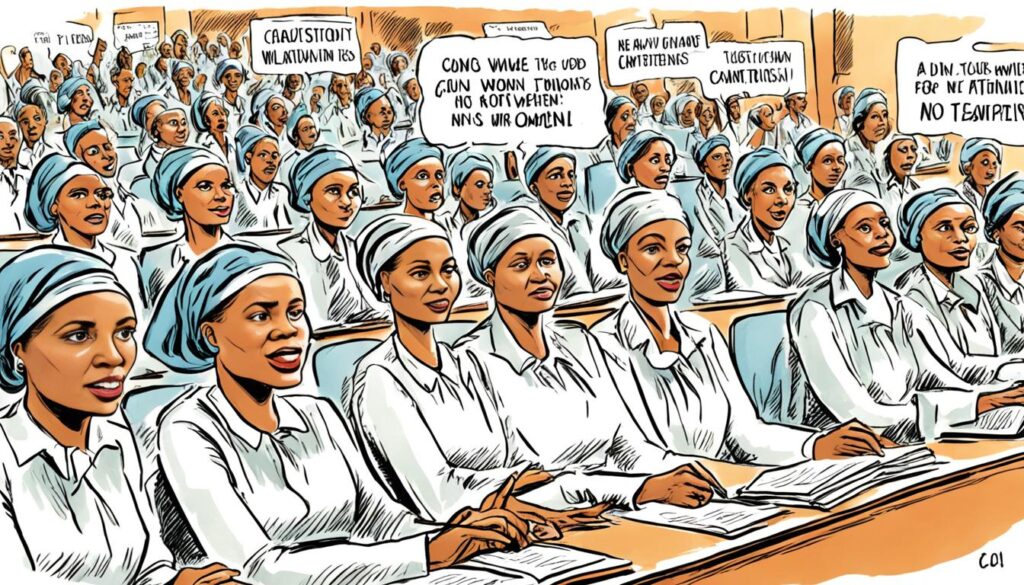
| Category | Statistics |
|---|---|
| Health and Nutrition | Significant improvement in maternal health indicators, reduction in malnutrition rates among women and children |
| Economic Opportunities | Increase in women’s participation in formal employment, entrepreneurship, and leadership positions |
| Ownership and Control of Assets | Rise in women’s land ownership, improved access to credit and financial resources |
Regional Challenges Affecting Gender Equality Data
Achieving accurate gender equality data in Africa is essential for monitoring progress and implementing effective interventions. However, there are several regional challenges that hinder the collection and analysis of such data.
Coordination and Communication Gaps
One major challenge is the coordination and communication gaps among stakeholders involved in data collection. Due to limited coordination, multiple organizations and institutions often duplicate efforts, resulting in inefficient use of resources and missed opportunities for collaboration. Effective communication channels need to be established to streamline data collection processes, share best practices, and ensure the harmonization of methodologies.
Policy and Legal Framework Limitations
The policy and legal framework surrounding data collection and analysis pose significant limitations. In some cases, there may be a lack of clear policies supporting gender equality data collection, leading to inconsistent practices and incomplete datasets. Additionally, the legal framework may not provide adequate protection for the privacy and confidentiality of respondents, which can affect data quality and limit participation in surveys or interviews.
To address these policy and legal challenges, there is a need for comprehensive reforms that prioritize gender equality data collection and analysis. Governments should enact laws and regulations that mandate the collection of gender-disaggregated data, ensuring the inclusion of marginalized groups. Strong policy frameworks will provide the necessary foundation for effective data-driven decision-making and targeted interventions.
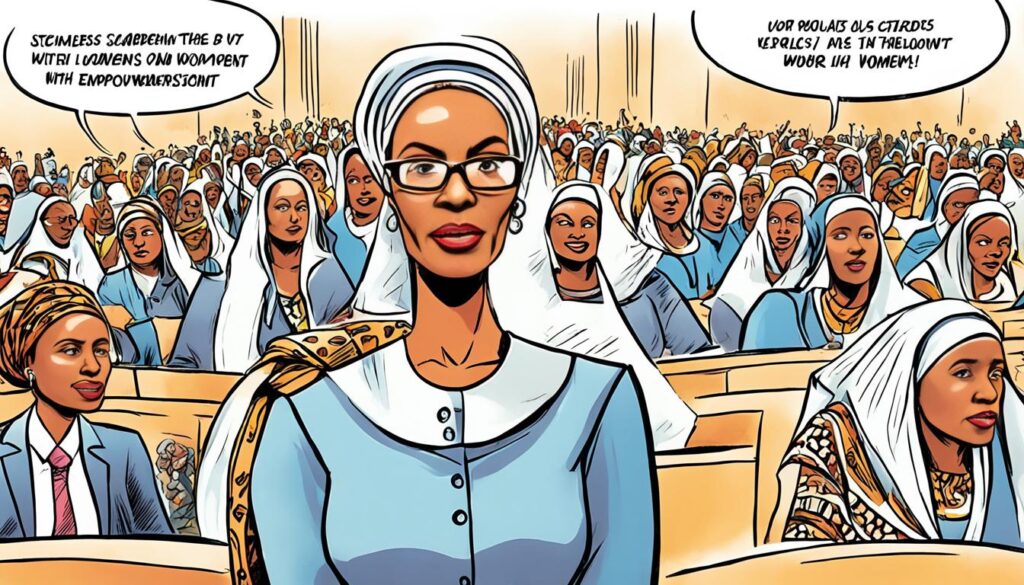
Increasing Access to Education and Economic Opportunities
Ensuring access to education and economic opportunities is crucial for women’s empowerment. By addressing existing barriers, we can create a more inclusive society that allows women to thrive and reach their full potential. In this section, we will discuss two key aspects: the impact of social safety net programs on women and the importance of supporting women entrepreneurs with capital and training.
Social Safety Net Programs and Their Impact on Women
Social safety net programs play a vital role in supporting women and promoting their overall well-being. These programs provide essential support and resources, such as healthcare, education, and financial assistance, to women who may otherwise face significant challenges. By ensuring access to these programs, we can uplift women and help them overcome various barriers.
Access to education, healthcare, and financial aid through social safety net programs has a profound impact on women’s lives. It enables them to pursue their education, improve their health, and secure necessary resources, creating a foundation for their empowerment.
These programs not only address immediate needs but also contribute to long-term empowerment. They provide women with the tools and opportunities to break the cycle of poverty, gain financial independence, and contribute to their communities’ development. By investing in social safety net programs, we can create a stronger, more inclusive society that benefits everyone.
Supporting Women Entrepreneurs with Capital and Training
Supporting women entrepreneurs is essential for fostering economic empowerment. By providing access to capital and training, we can empower women to start and grow their businesses, creating economic opportunities and self-sufficiency.
**Image description: An image showing women entrepreneurs engaged in a business meeting, symbolizing support for women entrepreneurs.**
Access to capital is often a significant challenge for women entrepreneurs, as they may encounter systemic barriers in obtaining funding. By providing financial resources tailored to women’s needs, we can help bridge this gap and enable women entrepreneurs to invest in their ventures.
“Supporting women entrepreneurs is not only an investment in their success but also in the overall economic growth and development of our society. By leveling the playing field and providing equal opportunities, we can unlock the immense potential of women-led businesses.”
In addition to capital, training and mentorship programs are crucial for women entrepreneurs. These programs equip women with the necessary skills, knowledge, and networks to navigate the business landscape successfully. By providing comprehensive support, we can empower women entrepreneurs to overcome challenges, develop sustainable businesses, and contribute to economic growth.
The Impact of Social Safety Net Programs and Support for Women Entrepreneurs
| Benefits | Social Safety Net Programs | Support for Women Entrepreneurs |
|---|---|---|
| Improved access to education | ✓ | × |
| Enhanced healthcare and well-being | ✓ | × |
| Financial assistance and resources | ✓ | × |
| Empowerment and self-sufficiency | ✓ | ✓ |
| Economic growth and job creation | × | ✓ |
Table: A comparison of the impact of social safety net programs and support for women entrepreneurs. While social safety net programs focus on providing essential support and resources, support for women entrepreneurs contributes to economic growth and job creation, along with empowerment and self-sufficiency.
Gender Disparities in Financial and Digital Inclusion
Gender disparities in financial inclusion and digital inclusion hinder women’s economic participation in Africa. Limited access to financial institutions, low rates of bank account ownership, and lack of digital literacy create barriers for women in accessing financial services and participating in the digital economy.
To address these disparities, it is important to prioritize financial inclusion initiatives that specifically target women, such as providing affordable and accessible financial services tailored to their needs. This can include increasing the availability of financial products like savings accounts, credit, and insurance that are designed to empower women economically.
Additionally, promoting digital inclusion is crucial to ensure women can benefit from the growing opportunities in the digital economy. This can be achieved through initiatives that focus on digital literacy training for women, as well as providing access to affordable and reliable internet services and digital devices.
By addressing the gender disparities in financial and digital inclusion, we can unlock women’s economic potential and contribute to their overall empowerment. It is essential to create an enabling environment that promotes equal opportunities for women and ensures their active participation in the economic and digital spheres.
The Economic and Social Implications of Unpaid Care Work
Unpaid care work, predominantly performed by women, has significant economic and social implications. Quantifying the value of unpaid care work highlights the contribution of women’s labor to the economy. The gendered nature of job security in paid care work further exacerbates inequalities and limits women’s economic empowerment. Recognizing and valuing unpaid care work and promoting job security in the care sector are essential for achieving gender equality and women’s empowerment.
The Invisible Labor: Quantifying Unpaid Care Work
Unpaid care work, which includes activities such as cooking, cleaning, caregiving, and household management, is often overlooked and undervalued. Yet, it plays a vital role in sustaining households and communities. Quantifying the value of unpaid care work helps us understand its economic significance and the extent of women’s contribution to society. By acknowledging and valuing this invisible labor, we can advocate for policies and interventions that address the economic implications of unpaid care work and promote gender equality.
Paid Care Work and the Gendered Nature of Job Security
Paid care work, such as nursing, childcare, and domestic work, is often feminized and undervalued. This gendered nature of job security in the care sector has far-reaching implications for women’s economic empowerment. Women in these roles often face precarious employment conditions, low wages, limited job benefits, and a lack of job security. Addressing the gendered nature of job security in paid care work is essential for creating more equitable working conditions and enhancing women’s economic opportunities.
Conclusion
As we reflect on women’s empowerment and gender equality in Africa, it is evident that while progress has been made, challenges still persist. Achieving women’s empowerment requires addressing various areas of concern. We must prioritize efforts to bridge educational disparities, improve maternal health, combat gender-based violence, ensure ownership of assets, and close gaps in access to education and economic opportunities.
Overcoming these challenges requires a concerted effort to address regional obstacles. Coordination gaps among stakeholders need to be addressed to optimize resource utilization and avoid duplication of efforts. Alongside this, policy and legal frameworks must be strengthened to support the development of robust gender statistics. By collecting and analyzing accurate data, we can better measure progress and implement effective interventions.
Strategic interventions are crucial for advancing gender equality in Africa. Through initiatives focused on health and nutrition, we can improve the well-being of African women. By boosting economic opportunities and entrepreneurship for women, we promote their economic empowerment. Additionally, advancements in ownership and control of assets, such as land and property, contribute to overall empowerment.
In conclusion, achieving women’s empowerment and gender equality in Africa requires a comprehensive approach. While challenges persist, progress has been made in various areas. By addressing disparities, overcoming regional challenges, promoting data collection and analysis, and implementing strategic interventions, we can continue to advance towards a more equitable and empowered Africa.

